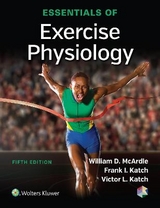
Essentials of Exercise Physiology
Lippincott Williams and Wilkins (Verlag)
978-1-60831-267-2 (ISBN)
- Titel erscheint in neuer Auflage
- Artikel merken
"Essentials of Exercise Physiology" offers a compact version of the Seventh Edition of the bestselling "Exercise Physiology: Nutrition, Energy, and Human Performance", making it ideal for introductory undergraduate courses. As students progress through the text, they will develop a deep understanding of the interrelationships among energy intake, energy transfer during exercise, and the physiologic systems that support energy transfer. Moreover, they will discover how to apply what they have learned to enhance exercise training, athletic performance, and health. Based on feedback from students and instructors, this Fourth Edition offers new organization, content, and features while maintaining its hallmark pedagogy, writing style, graphics, and flow charts. The new organization makes it easier to cover the text in a one-semester course and adapt materials to diverse interests. Plus, each section has undergone a major revision, offering readers coverage of new and emerging topics in exercise physiology as well as the latest research findings.
Section I: Introduction to Exercise Physiology Chapter 1: Origins of Exercise Physiology: Foundations for the Field of Study Section II: Nutrition and Energy Chapter 2: Macronutrients and Micronutrients Chapter 3: Food Energy and Optimum Nutrition for Exercise Chapter 4: Nutritional (and Pharmacologic) Aids to Performance Section III: Energy Transfer Chapter 5: Fundamentals of Human Energy Transfer Chapter 6: Human Energy Transfer During Exercise Chapter 7: Measuring and Evaluating Human Energy-Generating Capacities During Exercise Chapter 8: Energy Expenditure During Rest and Physical Activity Section IV: The Physiologic Support Systems Chapter 9: The Pulmonary System and Exercise Chapter 10: The Cardiovascular System and Exercise Chapter 11: The Neuromuscular System and Exercise Chapter 12: Hormones, Exercise, and Training Section V: Exercise Training and Adaptations Chapter 13: Training the Anaerobic and Aerobic Energy Systems Chapter 14: Training Muscles to Become Stronger Chapter 15: Factors Affecting Physiologic Function: The Environment and Special Aids to Performance Section VI: Optimizing Body Composition, Successful Aging, and Health-Related Exercise Benefits Chapter 16: Body Composition, Obesity, and Weight Control Chapter 17: Physical Activity, Exercise, Successful Aging, and Disease Prevention Chapter 18: Clinical Aspects of Exercise Physiology Appendix A: The Metric System and Conversion Constantsin Exercise Physiology Appendix B: Metabolic Computations in Open-Circuit Spirometry Appendix C: Evaluation of Body Composition: Girth Method Appendix D: Evaluation of Body Composition: Skinfold Method Index
| Verlagsort | Philadelphia |
|---|---|
| Sprache | englisch |
| Maße | 213 x 277 mm |
| Gewicht | 1679 g |
| Themenwelt | Medizin / Pharmazie ► Medizinische Fachgebiete ► Sportmedizin |
| Studium ► 1. Studienabschnitt (Vorklinik) ► Physiologie | |
| ISBN-10 | 1-60831-267-4 / 1608312674 |
| ISBN-13 | 978-1-60831-267-2 / 9781608312672 |
| Zustand | Neuware |
| Haben Sie eine Frage zum Produkt? |
aus dem Bereich



